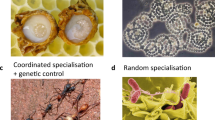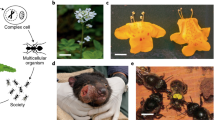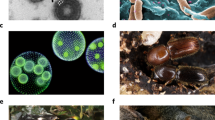Abstract
Cheating is a potential problem in any social system that depends on cooperation and in which actions that benefit a group are costly to individuals that perform them1,2,3,4,5. Genetic mutants that fail to perform a group-beneficial function but that reap the benefits of belonging to the group should have a within-group selective advantage, provided that the mutants are not too common. Here we show that social cheating exists even among prokaryotes. The bacterium Myxococcus xanthus exhibits several social behaviours, including aggregation of cells into spore-producing fruiting bodies during starvation. We examined a number of M. xanthus genotypes that were defective for fruiting-body development, including several lines that evolved for 1,000 generations under asocial conditions6 and others carrying defined mutations in developmental pathways7,8,9,10, to determine whether they behaved as cheaters when mixed with their developmentally proficient progenitor. Clones from several evolved lines and two defined mutants exhibited cheating during development, being over-represented among resulting spores relative to their initial frequency in the mixture. The ease of finding anti-social behaviours suggests that cheaters may be common in natural populations of M. xanthus.
This is a preview of subscription content, access via your institution
Access options
Subscribe to this journal
Receive 51 print issues and online access
$199.00 per year
only $3.90 per issue
Buy this article
- Purchase on Springer Link
- Instant access to full article PDF
Prices may be subject to local taxes which are calculated during checkout



Similar content being viewed by others
References
Maynard Smith,J. Evolution and the Theory of Games (Cambridge Univ. Press, Cambridge, 1982).
Axelrod,R. M. The Evolution of Cooperation (Basic Books, New York, 1984).
Pellmyr,O., Leebens-Mack,J. & Huth, C. J. Non-mutualistic yucca moths and their evolutionary consequences. Nature 380, 155– 156 (1996).
Matapurkar,A. K. & Watve,M. G. Altruist cheater dynamics in Dictyostelium: aggregated distribution gives stable oscillations. Am. Nat. 150, 790–797 (1997).
Frank,S. A. Foundations of Social Evolution (Princeton Univ. Press, Princeton,1998).
Velicer,G. J., Kroos,L. & Lenski,R. E. Loss of social behaviors by Myxococcus xanthus during evolution in an unstructured habitat. Proc. Natl Acad. Sci. USA 95, 12376–12380 ( 1998).
Kuspa,A., Kroos,L. & Kaiser,D. Intercellular signaling is required for developmental gene expression in Myxococcus xanthus. Dev. Biol. 117, 267–276 (1986).
Shimkets,L. J. & Asher,S. J. Use of recombination techniques to examine the structure of the csg locus of Myxococcus xanthus . Mol. Gen. Genet. 211, 63– 71 (1988).
Kuspa,A. & Kaiser,D. Genes required for developmental signaling in Myxococcus xanthus: three asg loci. J. Bacteriol. 171, 2762–2772 ( 1989).
Garza,A. G., Harris,B. Z., Pollack,J. S., Tzeng,L. & Singer,M. The asgE locus is required for cell-cell signaling during Myxococcus xanthus development. Mol. Microbiol. 35, 812–824 (2000).
Bonner,J. T. The Cellular Slime Molds (Princeton Univ. Press, Princeton, 1967).
Kaiser,D. Control of multicellular development: Dictyostelium and Myxococcus. Annu. Rev. Genet. 20, 539– 566 (1986).
Reichenbach,H. in Myxobacteria II (eds Dworkin, M. & Kaiser, D.) 13– 62 (Am. Soc. Microbiol., Washington, DC, 1993).
Dworkin,M. & Kaiser,D. (eds) Myxobacteria II (Am. Soc. Microbiol., Washington, DC, 1993).
Rosenberg,E. & Varon,M. in Myxobacteria: Development and Cell Interactions (ed. Rosenberg, E.) 109–125 (Springer, New York, 1984).
Kaiser,D. Social gliding is correlated with the presence of pili in Myxococcus xanthus . Proc. Natl Acad. Sci. USA 76, 5952 –5956 (1979).
Hagen,D. C., Bretscher,A. P. & Kaiser, D. Synergism between morphogenetic mutants of Myxococcus xanthus. Dev. Biol. 64, 284– 296 (1978).
Downard,J., Ramaswamy,S. V. & Kil, K. Identification of esg, a genetic locus involved in cell–cell signaling during Myxococcus xanthus development. J. Bacteriol. 175, 7762– 7770 (1993).
Laue,B. E. & Gill,R. E. Using a phase-locked mutant of Myxococcus xanthus to study the role of phase variation in development. J. Bacteriol. 177, 4089– 4096 (1995).
Buss,L. W. Somatic cell parasitism and the evolution of somatic tissue compatibility. Proc. Natl Acad. Sci. USA 79, 5337– 5341 (1982).
Nowak,M. A. & May,R. M. Evolutionary games and spatial chaos. Nature 359, 826–829 (1992).
Frank,S. A. Mutual policing and repression of competition in the evolution of cooperative groups. Nature 377, 520– 522 (1995).
Maynard Smith,J. & Szathmáry,E. The Major Transitions in Evolution (Oxford Univ. Press, New York, 1995).
Grosberg,R. K. & Strathmann,R. R. One cell, two cell, red cell, blue cell: the persistence of a unicellular stage in multicellular life histories. Trends Ecol. Evol. 13, 112 –116 (1998).
Buss,L. W. Slime molds, ascidians, and the utility of evolutionary theory. Proc. Natl Acad. Sci. USA 96, 8801– 8803 (1999).
Stoner,D. S., Rinkevich,B. & Weissman, I. L. Heritable germ and somatic cell lineage competitions in chimeric colonial protochordates. Proc. Natl Acad. Sci. USA 96, 9148–9153 ( 1999).
Turner,P. E. & Chao,L. Prisoner's dilemma in an RNA virus. Nature 398, 441–443 (1999).
Hodgkin,J. & Kaiser,D. Cell-to-cell stimulation of motility in nonmotile mutants of M. xanthus. Proc. Natl Acad. Sci. USA 74, 2938–2942 ( 1977).
Wall,D., Kolenbrander,P. E. & Kaiser, D. The Myxococcus xanthus pilQ (sglA) gene encodes a secretin homolog required for type IV pilus biogenesis, social motility and development. J. Bacteriol. 181, 24– 33 (1999).
Kroos,L., Kuspa,A. & Kaiser,D. A global analysis of developmentally regulated genes in Myxococcus xanthus . Dev. Biol. 117, 252– 266 (1986).
Acknowledgements
We thank A. Garza, L. Shimkets, M. Singer and J. Strassman for helpful discussion, A. Garza for providing strain MS2021, and N. Hajela and J. Jiang for technical assistance. This research was supported by Michigan State University and an NSF grant to R.E.L.
Author information
Authors and Affiliations
Corresponding author
Rights and permissions
About this article
Cite this article
Velicer, G., Kroos, L. & Lenski, R. Developmental cheating in the social bacterium Myxococcus xanthus . Nature 404, 598–601 (2000). https://doi.org/10.1038/35007066
Received:
Accepted:
Issue Date:
DOI: https://doi.org/10.1038/35007066
This article is cited by
-
Impact of direct physical association and motility on fitness of a synthetic interkingdom microbial community
The ISME Journal (2023)
-
Allopatric divergence of cooperators confers cheating resistance and limits effects of a defector mutation
BMC Ecology and Evolution (2022)
-
Hidden paths to endless forms most wonderful: ecology latently shapes evolution of multicellular development in predatory bacteria
Communications Biology (2022)
-
Somatic deficiency causes reproductive parasitism in a fungus
Nature Communications (2021)
-
Ten recent insights for our understanding of cooperation
Nature Ecology & Evolution (2021)
Comments
By submitting a comment you agree to abide by our Terms and Community Guidelines. If you find something abusive or that does not comply with our terms or guidelines please flag it as inappropriate.



